As an Amazon Associate I earn from qualifying purchases.
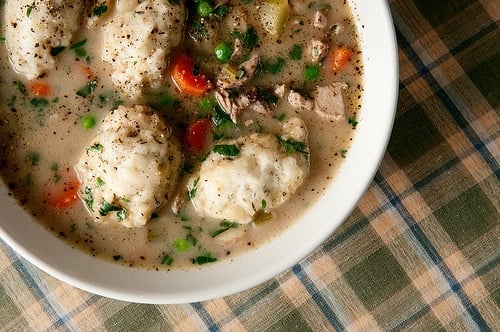
I did not grow up with chicken and dumplings. I’d always lumped the dish in with chicken-fried steak and biscuits and gravy; milk gravy makes my stomach turn. For decades, I’d just ignorantly tossed chicken and dumplings into the same culinary trashbin.
Then, one day, my friend Elise and I decided to remake her recipe for chicken and dumplings so we could get a better photo. One of the side benefits to this is that I get to eat the dish when Elise finishes photographing it. I was a little put off by the gigantic dumplings floating in the broth, but I figured it would make a decent enough lunch. I took a bite.
Wow. So that was what I’d been missing!
Big these dumplings may be, but they were as light as air and nicely coated with a silky chicken broth. The broth itself was the loveliest chicken soup I’d eaten in a long, long time. This wasn’t a Southern horror, like pickled pig’s feet. This was a wonderful dish, homey and layered at the same time. No wonder it was a classic.
Chastened, I decided to adapt Elise’s recipe for wild game. Pheasant is the natural analog for the dish, but I’ve made it with ruffed grouse, too. Partridge, wild turkey, quail or even squirrel or rabbit would work well here, too. Squirrel and dumplings is actually a classic recipe in parts of the South.
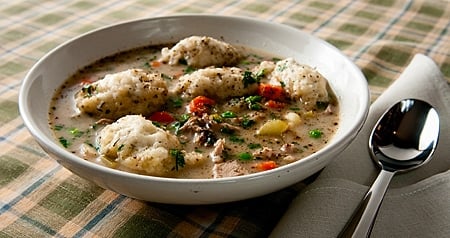
This is not a quick and easy dish. It is a dish of love, of time and of patience.
First you simmer the grouse to make a stock, then you pull the meat from the bones to return to the soup later. You strain the stock and rebuild the soup with what is essentially a French veloute, a combination of a flour-and-water roux and the hot stock. New veggies go in, as well as the pulled meat. You finish it off with the dumplings, which really do need the cake flour to be as light as possible.
I now make pheasant and dumplings with some frequency, and I’ve even learned to love wild game versions of chicken fried steak. But I still hate milk gravy.
Pheasant and Dumplings
Ingredients
BROTH
- 1 pheasant, 6-8 quail or the wings and carcass of a wild turkey
- Salt
- 2 carrots, chopped
- 2 celery stalks, chopped
- 1 large onion, chopped
- 1/2 a parsnip, or 1 small parsnip
- 2 bay leaves
- 2 teaspoons dried thyme
- 1 ounce dried mushrooms, any kind
STEW
- 4 tablespoons unsalted butter
- 2 carrots, sliced into rounds
- 2 celery stalks, sliced about 1/4 inch thick
- 1/2 a parsnip, or 1 small parsnip, chopped
- 4 tablespoons flour
- 1/2 cup vermouth or dry sherry
- 1 cup fresh or frozen peas
- 1 cup chopped parsley
- 1/4 cup heavy cream
- Salt and black pepper
DUMPLINGS
- 2 cups cake flour
- 2 teaspoons baking powder
- 1 teaspoon salt
- 2 tablespoons melted butter
- 3/4 cup milk
Instructions
- Start with the broth. Toss all the broth ingredients into a large stockpot, cover with at least 2 quarts of water (you can save any extra broth for later) and bring to a strong simmer, about 200 degrees if you're checking. Drop the heat to below a simmer -- look for lots of steaming, and just a couple bubbles on the surface -- and let everything cook 20 minutes. Fish out the pheasant and remove the breast meat. Set it aside in the refrigerator and return the rest of the pheasant to the pot. Cook for as long as it takes for the meat to want to fall off the leg bones, from 45 minutes for a pen-raised bird to 2 1/2 hours for an old rooster.
- When the pheasant is done, gently remove it from the broth and let it cool enough to handle. Pick off all the meat from the bones, being sure to remove all those nasty tendons in the pheasant's legs. Put the meat in the bowl with the breast meat. Take the breast meat and shred it, then return everything to the bowl.
- Strain the broth. Using a spider skimmer or slotted spoon, remove as many big pieces of vegetable as you can from the broth. Put a fine-meshed strainer that has a paper towel set inside it over a large bowl or pot. Pour the stock through this. You might need to change paper towels halfway through if it gets too gunked up. Pour the broth into a pot and set it on low heat.
- To make the stew, heat the butter in a large pot or Dutch oven set over medium-high heat. Saute the carrot, celery and parsnip for 3-4 minutes, stirring often. You don't want the veggies to brown. Add the flour and stir to combine. Everything in the pot will seize up, but that's OK. Drop the heat to medium-low and cook, stirring often, until the flour turns the color of coffee-with-cream. Add the vermouth and stir well, then start adding the broth 1 cup at a time, stirring constantly, until it looks silky. It should take 6-8 cups.
- Add the pheasant meat and bring this to a simmer. Cook gently until the veggies are soft, about 30 minutes.
- Meanwhile, make the dumpling dough. Mix all the dry ingredients together, then add the melted butter and milk. Stir just to combine -- do not overwork the dough.
- Drop the dough by the teaspoonful into the simmering stew. When all the dough is in, cover the pot and cook over low heat for 15 minutes. It is very important that the stew not boil during this time, or your dumplings will get tough.
- After 15 minutes are up, uncover the pot and add the peas and parsley, stir gently to combine. Let this cook 1-2 minutes, then turn off the heat. Add salt and black pepper to taste, then the heavy cream. Serve at once.
Nutrition
Nutrition information is automatically calculated, so should only be used as an approximation.

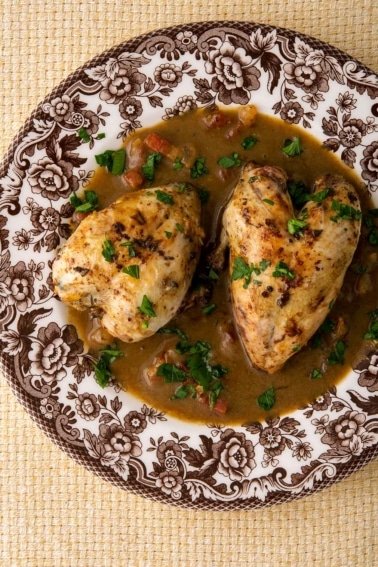
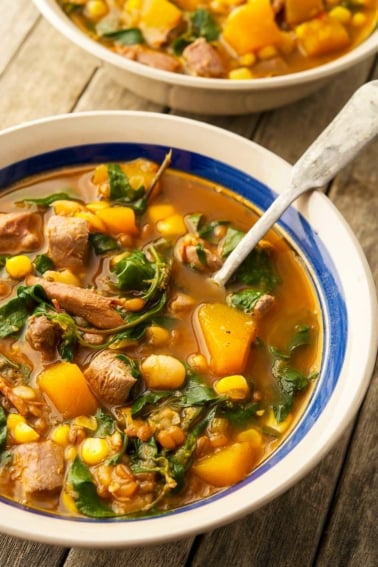
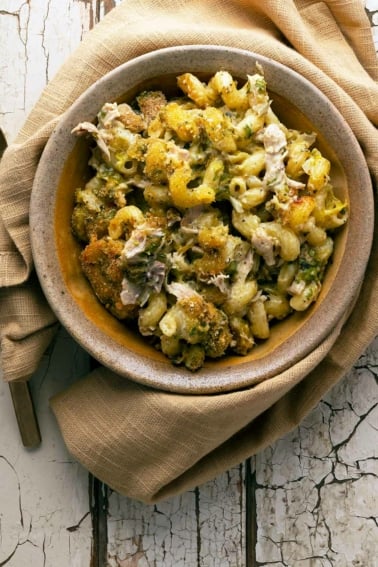
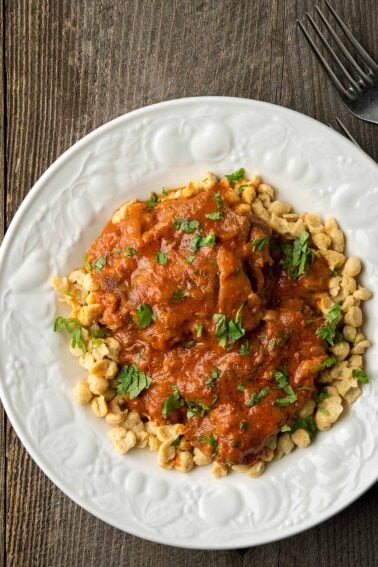
Never was a dumpling fan. I am now; wish that I had doubled the recipe!
I’m a little confused by your claim that milk gravy is disgusting. What about it turns you off? Have you had proper sawmill gravy made with a roux? I assume you’ve tried it enough that you know what you’re talking about, but I really don’t see how someone could not like good biscuits and gravy, with its assertive earthiness.
Milk gravy, or white gravy as we called it, is common in the areas of KY & TN where my parents are from. It was mostly a mid-day gravy.
Mornings meant red-eye gravy. Red-eye gravy over my mama’s lard biscuits with home-cured country ham is ambrosia.
I grew up eating chicken & dumplings and never thought to use upland game. Looks like I will be doing so next fall.
Good stuff. One of the treats of my childhood, and probably the impetus to keep me hunting, was my grandmother’s squirrel and dumplings. My dad and I would go out in the morning to shoot a mess of squirrels on Saturday, and we’d be eating them for Sunday dinner. Poor people food? Maybe. But damned good stuff.
As far as gravy, I’d always seen “milk gravy” as yankee food… not southern. But that could just be the household where I was raised. I expect, like most of these comfort food recipes, that one traverses the Mason-Dixon line with aplomb.
Mouth watering and so adaptable to any kind of game.
Interesting that you talk about cake flour. This is the ONLY type of flour we can get here.
Josh,
I made the vin de noix that I gave Hank this year. I macerated the green walnuts for three months before straining. I used English green walnuts. I made my first batch of nocino in 2006 with English green walnuts. I made my next batch of nocino last year with black walnuts. This year, I made separate batches of nocino with English and black walnuts.
Since English walnuts do not grow here, I have to mail order English green walnuts (highway robbery). I have started to find places here for black walnuts. Trying to harvest green walnuts with an apple picker is kind of comical.
I did a tasting of all the nocino that I have made for a chef friend and his bar staff. They liked the 2006 nocino the best but thought that the expense incurred for acquiring English walnuts is not worth it since it is possible to pick local black walnuts.
Julia, we should exchange notes on green walnut stuff; I’ve got a whole page and have been working with them for three years now. How long did you age your vin de noix? I gave Hank a bottle of nocino a couple years back, and it was okay, but when I gave the same vintage this year to a friend back East, she fell in love with it – so, aging obviously helps…
Bobby Nations, that’s exactly the same gravy I grew up with! Great stuff!
That looks so good. Thank you for sharing this.
Julia: It will not be so good with skinless pheasant breasts. You want the whole bird to make the broth. Better to make marsala or piccata with those breasts. And I never tried the jam — I don’t eat jams or jellies — but I liked the walnut liqueur!
Let’s be rational here. Where I come from, the words “lothe” and “Chicken Fried Steak” in the same vicinity are fighting words. 🙂
Hank, thanks for this.
When I was a kid, I’d hunt squirrel and partridge all through the fall, and we’d keep them in the freezer. My step-father would make what we called a squirrel or partridge pie – which sounds really similar to this. We’re not Southern – a several generation Vermont and Northern New England family.
As I remember it, it was dumplings on the bottom and top, with meat and sauce in between. I was with my siblings over the weekend, and we all commented on how delicious it had been. Think I’ll try this one!
Robert
Hank,
In my family, sawmill gravy is not the same as milk gravy.
The sawmill gravy dishes that I have eaten in various restaurants all came out very thick with lots of sausage patty bits floating around in them. The taste was okay but the texture was weird to me as the gravy would visibly congeal on the biscuit during the meal. By the end of breakfast, sawmill gravy usually has turned to glue.
Now, my Grandmother’s (and to a lesser extent, my Mom’s) milk gravy was a whole other dish entirely.
I’m working from memory here, plus I’m not really a good cook, so apologies in advance. She would start with a light brown roux made from whatever drippings were left from the morning’s meat portion. But not all of the drippings — only maybe 3 tablespoons or so — otherwise the meat would overpower everything. She also didn’t use much flour and didn’t brown it for long, so the gravy stayed white with mocha swirls. The light-colore roux might also explain why it never turned into glue on the plate. And here’s the main difference between her milk gravy and sawmill gravy, she used a *lot* of milk. The final texture was very thin and soupy and would actually soak into the biscuit (this was important because she always made pretty crusty biscuits and they needed some tenderizing). Oh, and she added lots of black pepper to finish the dish.
The final product had a very mild taste, sort of silky and buttery with some meat flavors hiding in the background. Oddly enough, it didn’t really taste like milk, per se, possibly because the pepper finish and the meat undertones. It was wonderful stuff. I’ve never had it anywhere else, and to date haven’t been able to replicate it myself.
P.S. I’m from the South.
That looks really good. I believe I will have to try it!
A friend has many frozen skinless pheasant breasts. Would it be possible to make your recipe with them? Also, did you like the jam/liqueur that I gave you in Boulder? I think the jam was Italian prune plum elderberry honey and the liqueur was English green walnut Vin de Noix.
Thank you.
Aw, Hank! You haven’t had my sawmill gravy cooked with sausage in the pan drippings of a cast iron skillet! It is deliciously wonderful and belongs on chicken-fried and country-fried steak, especially if you are having mashed potatoes! In the morning is when we typically have the red eye gravy with biscuits and country ham. Your dumplings are much different then the ones I’m used to, but drew me in as the dish looks warm and comforting!
I have a bunch of skinned pheasant breasts, some with a little bone. Would this recipe work with them?
Also, have you tried the jam/liqueur that I made and did you like them? I believe that the jam was Italian prune plum elderberry with honey although there very likely were more. The liqueur that I remember is green walnut Vin de Noix.
Thanks.
Julia
Kevin: I might be converted on chicken fried steak, but sawmill gravy is just awful. I prefer red-eye gravy, which is harsher and based on black coffee.
Never thought of using cake flour, since it’s…not cake and all. The last time I made a non-cake item with cake flour the texture was not good, but this sounds like a great idea.
My mother-in-law makes the best dumplings but her’s are rolled out slightly so that you don’t end up with a ‘raw dough’ center.
Hatin’ on chicken fried steak and white gravy(sawmill, sausage, etc)! And all of this time I thought you were okay!
I have SO been put off pheasant since cooking/eating one that had been hung for what tasted like 6 years. Eurgh. It took days for the smell of it to leave my house and I still get the shivers when I think about eating it. Next time I get a brace, I’m going to try them fresh, no hanging at all.
That said, this dish looks scrummy and may just copy the chicken version!
Even the Better Homes and Gardens chicken and dumplings (my go-to) is awesome! I really didn’t think you’d be so dismissive of a food without first trying it… you know, since you occasionally throw wild duck feet into boiling water.